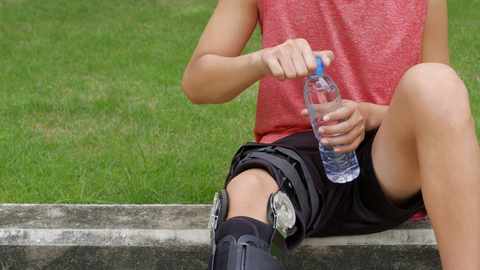
Leg Braces to Help You Walk
Take a walk down any busy street and it’s likely you will encounter a handful of people wearing some type of leg brace. Leg braces come in all different shapes and sizes and serve a number of important purposes including stabilization, joint unloading, and biomechanical enhancement. Although a wide variety of products exist on the market today, the ultimate goal of any leg brace should be to reduce your pain and improve your ability to walk and function.
What is a leg brace?

A leg brace is a generalized term used to describe any structure or device that is applied at or around the lower extremity to help relieve pain and discomfort. The actual construction of these devices can vary from low-profile nylon compression sleeves to heavy-duty braces made out of metal or aluminum. Regardless, all types of leg braces serve to help individuals find relief from musculoskeletal issues.
What is the purpose of a leg brace?

Leg braces serve many purposes from offloading to stabilization. Although grouped into a broad category, leg braces can be used for injuries that occur to the femur, knee joint, lower leg, ankle or foot. Appropriate application and fit of a leg brace will be unique to the individual user and in line with their therapeutic goals.
On the whole, leg braces can be used to reduce swelling, offload or unload a joint, improve joint tracking, limit or facilitate range of motion, enhance stabilization and prevent further injury. Most people will use leg braces short-term during periods of recovery although others with permanent disabilities may rely on them long-term.
Should a leg brace be tight?
When it comes to brace application, It’s important that your device is properly fit and lines up with your joint structures to be most effective. The fit should be snug enough that it is secure and supportive, but not so tight that you risk cutting off circulation to the lower leg. A good measure is the “two-finger test”. After you’ve applied your brace, stand up and attempt to slip two fingers into your brace. If you can’t get your two fingers in, the device is likely too snug and should be loosened. Conversely, if you feel little to no resistance, tighten the device until your fingers can just barely fit to ensure proper support.
What conditions require a leg brace?
Leg braces can be used for almost any lower-body injury involving the foot, ankle or knee. Experienced any one of the following? Then you probably could benefit from a leg brace:
- Fractures of the foot and ankle
- Femur fracture
- Tibial plateau fractures
- Knee replacement
- ACL reconstruction
- Meniscal repair
- Microfracture of the knee
- Achilles repair
- Bunionectomy
- Osteotomies
- Patellar fractures
- Post-op neuromas
- Plantar wounds
Leg braces are by no means one size fits all. That said, in many cases, such as after an injury or surgery, they work to protect injured or repaired tissues, help stabilize surrounding tissues and facilitate the healing process. In supporting and offloading damaged tissues, they can expedite your recovery and help you, quite literally, get back on your feet.
Should I wear my leg brace in bed?
In general, leg braces are most protective during weight bearing activities like walking or stair climbing. In these instances, they can prevent force from transferring through healing tissues or stabilize against joint buckling. That said, unless you are directed by your physician, leg braces are typically not required while in bed. Always consult your medical team before applying a brace and make sure to clarify appropriate use for your specific condition.
Do leg braces actually work?
Now the burning question- do these things actually work? With so many products on the market today, it’s important to find a product that is dependable, durable and well-researched. Different people will have different needs from their leg brace so finding a product that supports your therapeutic objectives and comes from a reputable brand is the ultimate goal. With the correct fit and appropriate indications for use, leg braces can provide significant support and relief for a wide variety of lower body conditions.
What is the Freedom Leg Crutch?

So what’s the best leg brace on the market for joint protection following an injury or surgery? If you’re looking to preserve your independence while allowing your tissues to heal, look no further than the Freedom Leg. Designed as a crutch alternative the Freedom Leg fits like a leg brace but works to completely offload your injured leg without having to use any sort of upper body aid. That means no crutches, no cane, no nothing! Imagine hands-free mobility that allows you to carry on with your regular activities like nothing ever happened. Seems too good to be true? It’s not!
Made with high-quality materials, the Freedom Leg seamlessly redistributes ground force through aluminum side rails to secured upper thigh straps bypassing your injured body part. Every component from the footplate to the thigh straps is adjustable to match unique body shapes as well as day-to-day fluctuations in swelling levels and clothing choices.
When it comes to daily functioning, the Freedom Leg actually facilitates you, unlike the inconveniences of traditional crutches. Walk the mall, push your shopping cart, or lift up your child with confidence and ease.
Ready to get back to living? Give the Freedom Leg a try and get ready to experience the best leg brace on the market today.
Regain Your Freedom!

- Regular price
- $395.00
- Sale price
- $395.00
- Regular price
-
$499.00 - Unit price
- per
Dr. Stelmaschuk
"Family Physician, had to have both of his feet repaired and found Freedom Leg very helpful, allowing him freedom to continue particing medicine and even running his snow blower"
Brandon Wise
"Broke his ankle and had to have surgery. The surgeons put screws in his ankle and told him not to put weight on it for 90 days. He was prescibed crutches. Fortunately he discoved Freedom Leg while looking for alternatives on the internet and was able to walk again without difficulty"



